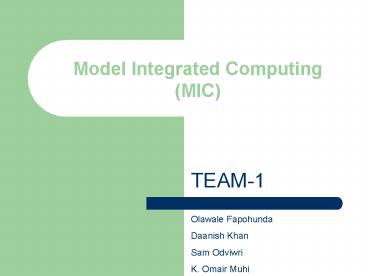Model Integrated Computing MIC - PowerPoint PPT Presentation
1 / 23
Title:
Model Integrated Computing MIC
Description:
Less chance of introducing bugs when. making changes. How is this achieved? ... Workshop on Component Models and Systems for Grid Applications , June-July 2004. ... – PowerPoint PPT presentation
Number of Views:53
Avg rating:3.0/5.0
Title: Model Integrated Computing MIC
1
Model Integrated Computing (MIC)
TEAM-1
Olawale Fapohunda Daanish Khan Sam Odviwri K.
Omair Muhi
2
Overview
- Introduction Background
- MIC in industry
- Sample application
- Future directions
- Conclusion
3
Some Definitions
- Models Formal structure representing selected
aspects of the engineering artifact and its
environment - Modeling Usage of abstractions (models) as
programming elements - Model-Based Systems Systems employing concepts
of modeling - Provides basis for solving complex systems
4
Motivation
- Software interaction with systems
- Embedded systems e.g. car brakes
- Tight integration
- Software and physical systems must evolve
together
5
Model Integrated Computing
- Captures software architecture and environment
- Dependencies and constraints among various
modeling views - Rapid design and implementation of systems
6
Model Integrated Computing (contd)
- Extending the scope and use of models
- Modeling paradigms matched to the needs of the
domain engineers - Provides framework for developing domain
artifacts for computer-based systems
7
Domain Specific Modeling
- 1
8
MIC Design Flow
- Models composed of reusable components
- Can be built and tested independently
- Doesnt require knowledge of models outside
focus area
9
MIC How its used
- Industrial Applications
- Industrial Robotics
- Vehicle Design
- Non-Programming related fields
- Technicians dont need to know about C/C
- Wide variety of concerns
- Performance
- Safety, etc
10
MIC The specifics
- Develop Domain Specific Modeling Environment
(DSME) - Your reusable models for your application
- Examples NI Labview, Matlab/Simulink
- Embed constraints into the model (OCL)
- Specific model behaviors
- Some buzzwords
- Multi-View Modeling of Cross-Cutting Constraints
- Meta-Code Generation
- Framework Coupling and Merging
11
GME Generic Modeling Environment
- Toolkit for creating domain-specific design
environments (DSDE DSME) - Specify meta-model using UML/OCL
- Meta-model interpreted into configuration for
GME, becomes DSME - Popular GMEs include
- GME2000
- Dome by Honeywell Research
12
MIC in Industrial Robotics
- Hard real-time constraints
- MIC reduces debugging time for
- Non-linear dynamics
- Kinematics models
- Sam will cover in more detail
13
An Application of MIC in Robot Control systems
- Area of Application Platform independent
automated code synthesis of dynamics models - Benefits
- Flexibility in model specification and usage
- Dynamic adaptation and reconfiguration of
- model.
- Much less debug iterations
- Less chance of introducing bugs when
- making changes
14
How is this achieved?
- Mechanical parts modelling
- Multi Body System (MBS)
- a finite set of primitive components
- joints, springs, links and drives.
- Dedicated algorithm
- compute torque, plan path, calibrate, etc.
- Modularity design
- Parts and components
- model Database
15
Putting all together...
- Model component interaction via ports
- Transmission objects
- A manipulator object serves as a center control.
- Creates and connects transmission objects
- serves as the domain specific code generator
- performs model re-configuration
16
- Left A generic 3 freedom robot
- Right A possible MBS model representation
17
How does it run?
- Execution
- a set of routines declared in the transmission
- interface (domain specific).
- Transmission objects
- contain concrete implementation
- Run based on interpreted or generated code by
manipulator.
18
Stages involved in the domain specific code
generation
19
Future directions of MIC
- Scalability of supporting tools
- distributed simultaneous access to models
- version control
- challenge respecting interdependencies
19
20
Future directions of MIC (contd)
- Improving model-interpreter generation
- writing model interpreters viewed as a bottleneck
- exploit GGT to solve bottleneck problem
21
Conclusion
- MIC concept
- GME and industry applications
- Sample application robot manipulator
- Future directions
22
References
- R. Hopler, P. J. Mosterman, Model Integrated
Computing in Robot Control to Synthesize
Real-time Embedded Code," Institute of Robotics
and Mechatronics - J. Sztipanovits, G. Karsai, Model-Integrated
Computing, Integrated Engineering, April 1997 - A. Ledeczi, G. Balogh, Z. Molnar, P. Volgyesi, M.
Maroti, Model Integrated Computing in the
Large, Institute for Software Integrated Systems
(ISIS), 2003 - A. Agrawal, Graph Rewriting And Transformation
(GReAT) A Solution For The Model Integrated
Computing (MIC) Bottleneck , ISIS, Vanderbilt
University - Hernandez.F, Bangalore.P, Gray.J, Reily.K , A
Graphical Modeling Environment for the Generation
of Workflows for the Globus Toolkit , Workshop
on Component Models and Systems for Grid
Applications , June-July 2004. - A. Ledeczi et al. Metamodel Composition in the
Generic Modeling Environment, Institute for
Software Integrated Systems (ISIS), Vanderbilt
University, 2003
23
- QUESTIONS?































